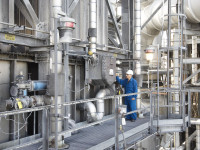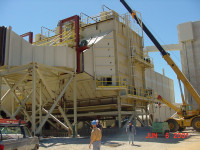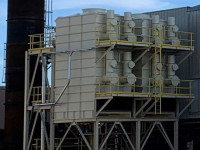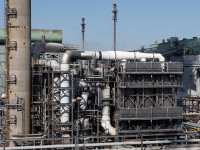Wet Electrostatic Precipitators (WESP)
Fine particulate, condensables and acid mist collection
B&W’s experience with electrostatic precipitator (ESP) technologies, both wet and dry, includes not only our established OEM experience base and expertise, but that gained through strategic acquisitions and licenses such as:
- Hamon Research-Cottrell – acquired in 2022
- SLF Romer (F.L. Smidth Airtech) – licensing agreement since 2003
- Joy Environmental and Western Precipitation – acquired in 1995
Our combined experience includes more than 5000 ESP installations, worldwide.
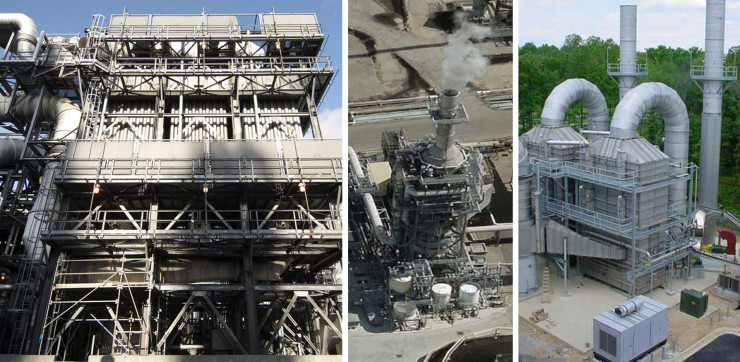
Fine particulate, condensables, acid mist collection
Dr. Frederick Cottrell developed the first wet electrostatic precipitator in 1907 to control sulfuric acid mist from a copper smelting process. Since that time wet ESP technology has become well-established around the world in both industrial and utility applications to remove sub-micron particulate, condensables and sulfuric acid (H2SO4) mist. It is especially useful as a final polishing device in air pollution control systems where an upstream dry ESP, fabric filter or wet scrubber cannot capture the sub-micron particulate or acid mist due to its small size.
When wet flue gas desulfurization (FGD) systems or wet scrubbers are used for sulfur control, wet ESPs have also proven to be effective in collecting H2SO4 and other condensables, along with fine particulates, reducing opacity concerns at the stack.
In addition to reducing emissions and opacity from a stack, wet electrostatic precipitators can be used to recover valuable product from a process gas.
Operation
Wet and dry ESPs operate on the same basic principles:
- Charging of incoming particulate with negative ions from corona generation using a high voltage system
- Collection of the negatively charged particulate on a positively charged collection electrode surface
- Cleaning of the captured particulate on the collecting electrode surface via use of water sprays, irrigation or condensation versus rapping or sonic horns. Cleaning methodology is the primary difference between dry and wet ESP operation.
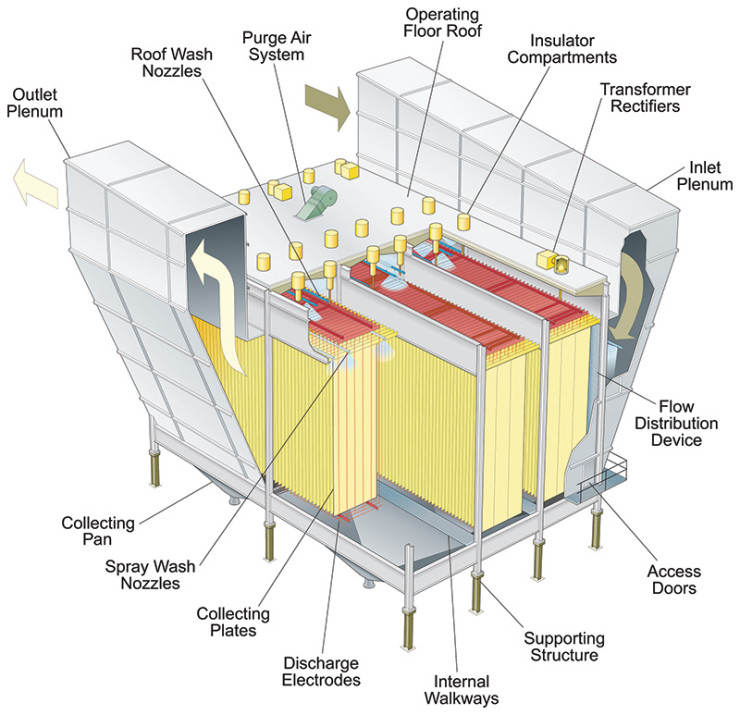
Design/Configuration
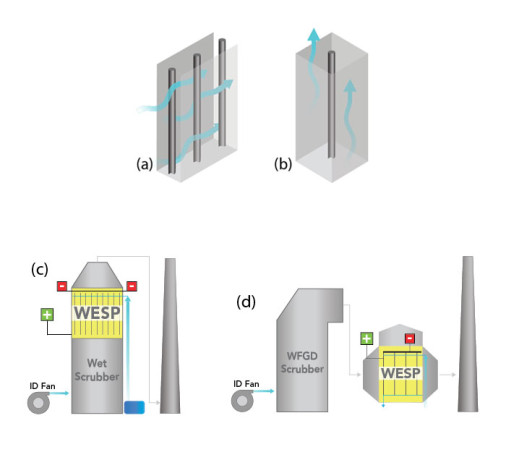 Wet electrostatic precipitators are generally configured in one of two ways:
Wet electrostatic precipitators are generally configured in one of two ways:
- Horizontal gas flow with flat plate collecting electrodes (a)
- Up-flow tubular configuration (b)
Collecting tubes are typically round, square or hexagonal. B&W’s expertise includes both plate and tubular designs.
A wet ESP can be integrated into the scrubber/absorber tower (c), or it can be located after the scrubber (d) where the flue/process gas has been cooled to moisture saturation. Once cooled, gaseous pollutants condense to form sub-micron aerosols that can be captured within the wet ESP.
A complete wet ESP system typically includes the following components:
- Collecting electrode system
- Discharge electrode system
- Positive insulator vent system
- Internal wash systems
- Transformer rectifiers and controls
- Casing
Features and benefits
- Performance – over 90% collection efficiency typical and up to 99% possible*
- Compact Size – minimizes space and cost
- Opacity – less than 10% possible*
- Reliability – well-established technology in hundreds of applications
- Fuel Flexibility – applicable for various fuels
- Multi-Pollutant Control – sub-micron solid particulate, condensables, and sulfuric acid mist
- Modular Design – allows for scale up to any size air flow and ease of installation
- Simple Maintenance – no moving mechanical parts; continuous self-cleaning
- Pressure Drop – typically less than 1 in. wg (0.25 kPa) through the wet ESP
- System Integration – total system capability with other pollution control devices
*when integrated as part of an appropriately designed emissions control system
Applications
B&W’s wet ESP system design is based on our extensive experience with a wide range of industrial, refinery and power applications, including:
- Particulates and sulfuric acid mist from petroleum refinery processes
- Sulfuric acid plants
- Regeneration of spent acids in chemical plants
- Metallurgical sulfuric acid plants in zinc, copper and nickel applications
- Organic fumes such as those generated in fiberglass production applications
- Organic fumes and particulates from sinter plants and steel mills
- Utility power plants
In addition, our wet electrostatic precipitator technology can be utilized as effective gas pre-treatment in post-combustion carbon dioxide (CO2) capture applications to protect the downstream CO2 capture reagent from contamination.
Click to view larger images.
Electrostatic Precipitator (ESP) Rebuilds & Upgrades
Improvements for decreased emissions and improved efficiency
Aging technology and lack of support from some original equipment manufacturers has resulted in lost productivity and reduced efficiency for many electrostatic precipitator systems. ESP products and services provided by B&W are designed with one goal in mind— to help keep your ESP functioning at peak performance. Our vast industry experience enables us to provide integrated solutions to enhance equipment performance, regardless of original manufacturer. B&W’s ESP aftermarket parts, service and upgrade business, formerly known under the Preciptech brand name, provides engineered upgrades, quality components and services to help keep your ESP running efficiently and effectively.

Our combination of innovative products and services include:
- Collector plates
- Rapper components and parts
- Discharge electrodes
- Insulators
- Single- and 3-phase power supplies and controls
- Access doors and door seals
- Electrical performance enhancement hardware and software
- Upgrades, rebuilds and conversions
- 24/7 remote diagnostics
- Field services and operating and maintenance training seminars
- B&W can upgrade virtually any existing ESP, regardless of manufacturer.
